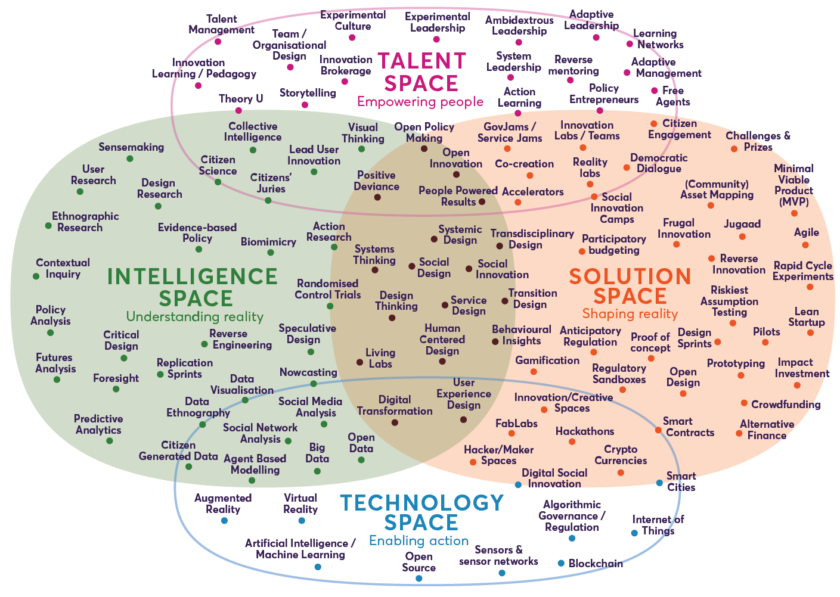Through our work in the Nesta Innovation Skills team, we often find ourselves being asked by governments and civil servants which innovation tools and techniques they should use. So what innovation approaches are there that can be applied in the public sector? And how are they related to each other?
With these questions in mind, over the last couple of years we’ve been mapping out the various innovation methods and approaches we’ve come across from studying innovation practice and our many conversations with different lab practitioners, colleagues and other innovation experts.
The map we’ve created provides an overview of innovation methods and approaches that help people make sense of reality, and approaches that help develop solutions and interventions to create change.
Understanding and shaping reality
The approaches mapped out in the diagram are structured into four spaces: intelligence, solution, technology and talent. These spaces are built on the premise that in order to create change, you need to make sense and understand reality, as well as develop solutions and interventions to change that reality:
- intelligence space – focuses on approaches that help you make sense of and conceptualise reality
- solution space – focuses on methods that help you test and develop solutions
In terms of mindsets, you could say that the intelligence space is more academic, whereas the solution space involves more of an entrepreneurial approach. The activities in these are supported by two further spaces:
- technology space - includes approaches and technology that enable action and change, such as digital tools and data-related methods
- talent space - focuses on how to mobilise talent, develop skills and increase organisational readiness in order to ultimately make change happen
Challenging personal preferences and biases
In innovation labs, we often see that practitioners use more than one tool or method, and that they have a diverse set of skills to ‘get the job done’. For example, Nesta’s report on Innovation Teams shows that, in practice, design thinking is often used in conjunction with other methods such as open data, ethnographic research, challenge prizes or behavioural insights. Hence, in the diagram design thinking is positioned at the intersection of the intelligence and solution space.
We have also noticed that people often have a personal bias when considering innovation methods. For example, designers are generally strong advocates of design related methods such as design thinking or human centred design. When academics are involved in an innovation process, they can show a preference for more analytical methods. But it’s important to challenge these biases and look beyond our own disciplines at other methods. Hopefully this diagram will help you to identify your own biases and make better informed decisions when planning your innovation journey.
More information on the approaches
Although this map is neither exhaustive nor definitive – and at some points it may seem perhaps a little arbitrary, personal choice and preference – we have tried to provide an overview of both commonly used and emerging innovation approaches.
Some of these methods have been widely adopted, while others are more exotic and only serving a niche, but may eventually become more mainstream. Additionally, some are well codified through guides, toolkits and learning programmes, while others are still considered “dark arts” that are not yet fully understood and only used by a small group of early adopters.
To provide some guidance and clarity in general, we have listed all the approaches below and added links to resources that provide a definition and introductory information. Some approaches – especially the emerging or unusual ones (e.g. reverse engineering, smart contracts) – are not always well described or documented. Whereas more established approaches may be subject to disagreement or nuances of interpretation. For example, the meaning and value of ‘design thinking’ has been fiercely disputed and criticised since it has grown in popularity.
For these more “controversial” approaches, we haven’t picked a side with the reference we’ve provided. Instead, we’ve tried to refer to resources that we consider accessible, that don’t require prior knowledge and that provide a comprehensive introduction or definition that is generally accepted.
Have comments or suggestions on how to improve the map? Please let us know.
Intelligence space
These approaches help you make sense of reality, understand the causes and effects of issues, and identify opportunities. Activities are driven by an inquisitive and analytical mindset.
- Action Research
- Agent Based Modelling
- Big Data (PulseLab’s slidedeck on big data is also useful)
- Biomimicry (also see the Biomimicry Institute) [NEW]
- Citizen Generated Data (also see these case studies and this framework from Civicus)
- Citizen Science [NEW]
- Citizens’ Juries [NEW]
- Collective Intelligence (also see this book and Nesta’s Centre for CI Design)
- Contextual Inquiry
- Critical Design
- Data Ethnography
- Data Visualisation (also see this Nesta article)
- Design Research
- Ethnographic Research
- Evidence-based Policy (also see this guide from the Alliance of Useful Evidence and this collaborative)
- Foresight
- Futures Analysis (also see this toolkit from the UK’s Cabinet Office)
- Lead User Innovation ( also see this example)
- Nowcasting
- Open Data (also see this guide from PulseLab)
- Policy Analysis
- Predictive Analytics [NEW]
- Randomised Control Trials
- Replication Sprints [NEW]
- Reverse Engineering (also see this guide by COI)
- Sensemaking
- Social Media Analysis (also see this article from the Oxford Internet Institute)
- Social Network Analysis (also see this guide from the UK’s Home Office) [NEW]
- Speculative Design
- User research [NEW]
- Visual Thinking (also see this book by Dan Roam) [NEW]
Solutions space
These approaches help you test and develop solutions. Activities are driven by a generative and entrepreneurial mindset, aiming to shape reality.
- Accelerators (also see this example from the UAE)
- Agile (also see this manual on gov.uk) [NEW]
- Alternative Finance (also see this report from Nesta)
- Anticipatory Regulation
- Challenges & Prizes
- Citizen Engagement (and see this Wikipedia page)
- Co-creation
- (Community) Asset Mapping
- Crowdfunding (also see this Nesta article on crowdfunding public services and this Nesta pagewith links to various platforms)
- Crypto Currencies (also see this Nesta article on crypto currencies and crowdfunding)
- Democratic Dialogue
- Design Sprints (also see this article)
- FabLabs
- Frugal Innovation
- Gamification (also see this GovTech article and this guide from MJV Technology and Innovation)
- GovJams / Service Jams
- Hackathons (also see this guide by Joshua Tauberer, this Medium article and this example from Innovate UK)
- Hacker/Maker Spaces [NEW]
- Impact Investment
- Innovation Labs / Teams
- Innovation/Creative Spaces
- Jugaad
- Lean Startup (also see this book by Ann Mei Chang)
- Minimal Viable Product (MVP)
- Open Design
- Participatory budgeting (also see this article on The Long+Short) [NEW]
- People Powered Results [NEW]
- Pilots (also see this article from freeCodeCamp, or this web page) [NEW]
- Proof of concept (also see this article) [NEW]
- Prototyping (also see this article from Snook, these reflections and this article on prototyping for policy by Policy Lab)
- Rapid Cycle Experiments [NEW]
- Reality labs
- Regulatory Sandboxes (see this example in Dubai) [NEW]
- Reverse Innovation (Wikipedia)
- Riskiest Assumption Testing
- Smart Contracts [NEW]
- Social Innovation Camps (see this and this example from UNDP)
Intelligence - Solutions space
The crossover between the intelligence and solution space includes methods built on both mindsets. They aim to understand, as well as shape reality.
- Behavioural Insights (also see this guide by the Behavioural Insights Team)
- Design Thinking (also see this guide by Nesta & IDEO)
- Digital Transformation (alse see this article from FutureGov)
- Human Centered Design (also see this article from the US Digital Service and this article from Sabine Junginger)
- Living Labs
- Open Innovation (also see this Nesta report)
- Open Policy Making
- Positive Deviance (also see the Positive Deviance Initiative)
- Service Design (also see this manifesto by UK Gov’s design community, or check out this book and this playbook from the British Columbia government)
- Social Design (also see this guide from Lucy Kimbell and Joe Julier)
- Social Innovation (also see this EU programme, and the SIX platform) [NEW]
- Systemic Design (also see this guide from CoLab)
- Systems Thinking (also see this guide from the Waters Foundation, this primer by Donella Meadows, or this report by OECD’s OPSI team)
- Transdisciplinary Design
- Transition Design
- User Experience Design
Technology space
Approaches and technology that enable action and change, such as digital tools and data-related methods (at the intersection with the intelligence space).
- Algorithmic Governance / Regulation (also see this Nesta article)
- Artificial Intelligence / Machine Learning (also see this Nesta article)
- Augmented Reality (also see these articles from UNICEF)
- Blockchain
- Digital Social Innovation
- Internet of Things (also see the IoT Council)
- Open Source
- Sensors & sensor networks
- Smart Cities
- Virtual Reality (also see this article from TechCrunch)
Talent space
Approaches focused on mobilising talent, developing technical and leadership skills and increasing organisational readiness.
- Action Learning (here is an account of its origins) [NEW]
- Adaptive Leadership
- Adaptive Management
- Ambidextrous Leadership
- Experimental Culture
- Experimental Leadership
- Free Agents [NEW]
- Innovation Brokerage [NEW]
- Innovation Learning / Pedagogy
- Learning Networks [NEW]
- Policy Entrepreneurs [NEW]
- Reverse mentoring (also see this guide from Govloop and this reflection on ethnic minorities) [NEW]
- Storytelling (also see this guide from Ashoka) [NEW]
- System Leadership (also see this article from The Point People)
- Talent Management (also see this guide from The King’s Fund)
- Team / Organisational Design (also see this and this from The Ready, and this intro by Mollie West Duffy)
- Theory U [NEW]

